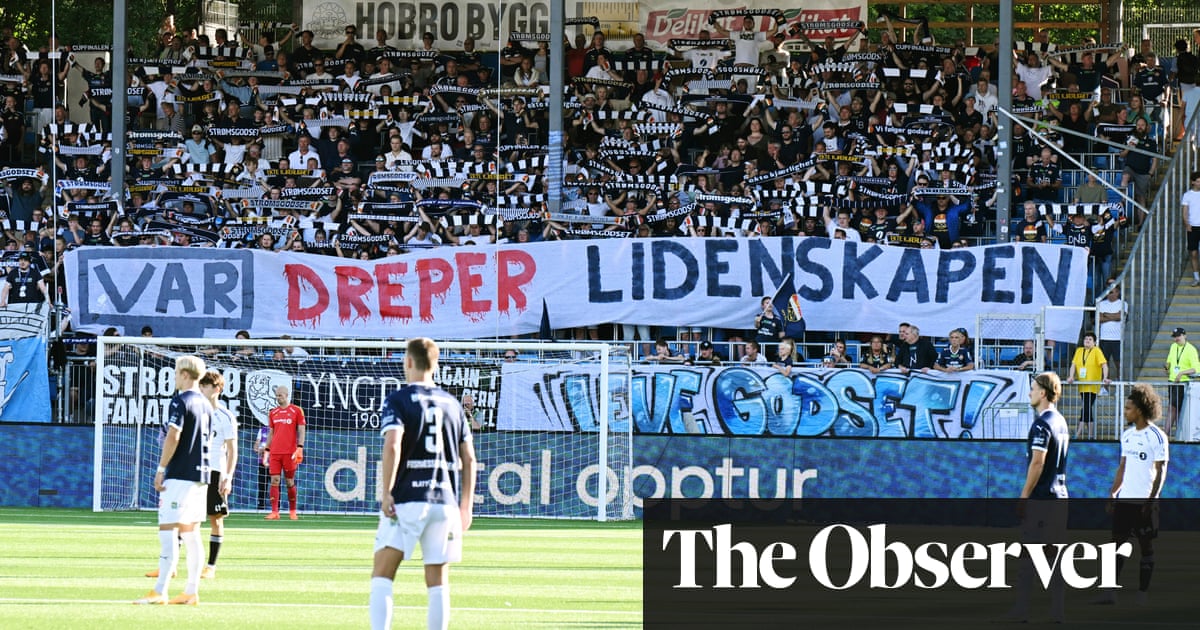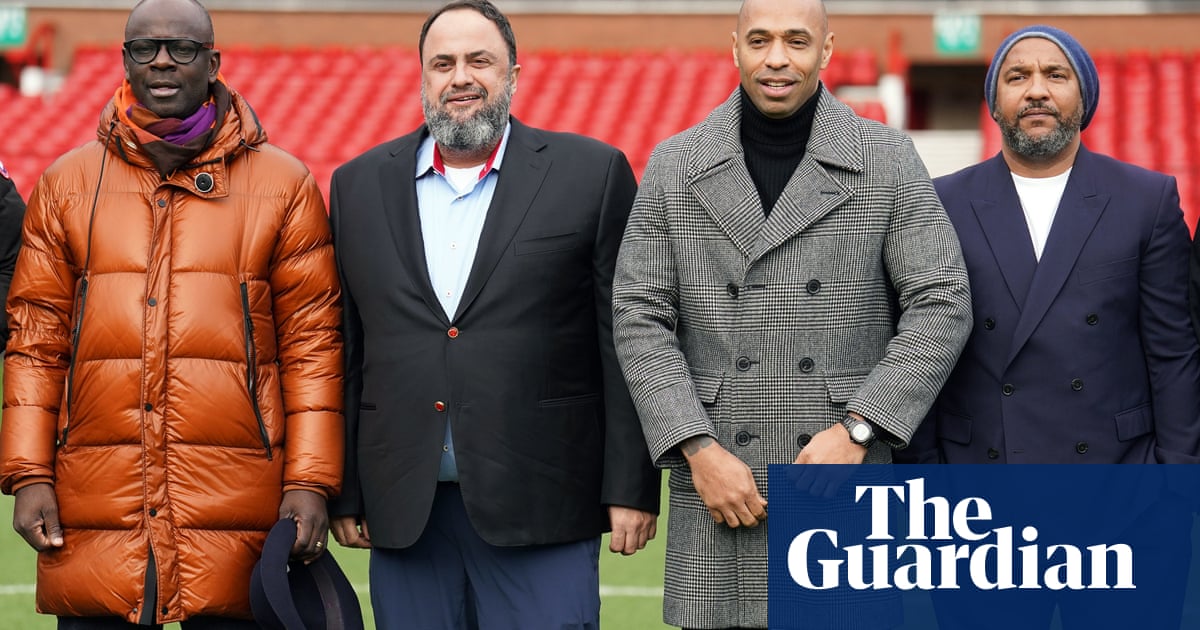
As soon as the first whistle blew in Stabæk’s home game against Viking, the hardcore of their support began filtering out of the stand. Tucked away in another section, the visitors’ fans remained in their places but observed a vow of silence. Play continued in an outwardly unremarkable Norwegian top-flight game midway through July, fogged slightly by smoke from flares being let off outside.
The last of Stabæk’s hardcore drifted out to reveal a banner, hung along the back of the terrace, that displayed their frustration in words. “VI VAR HER” (“We were here”), it read, with the middle word painted red for emphasis.
Questions over VAR’s viability have grown louder in England over the past week but, in swathes of Scandinavia, words have been matched by actions. The Stabæk support were among those enraged by the introduction of video technology to Norway’s Eliteserien in April with, they believed, a lack of consultation. Theirs was far from the only show of protest. Two months ago more than 70 different fan groups coalesced to ensure stadiums were silent for the first 15 minutes of two consecutive matchdays.
In a league whose match-going culture supersedes global television appeal, few appreciated the interference wreaked by VAR inside their grounds. Just as pertinently, supporters resented the fact it was railroaded through. Football clubs in Norway are member-run but many feel the subject was put on the table too quickly for fans to table it at their general assemblies, where boards could have been instructed to work against VAR’s introduction, earlier this year.
“When the debate suddenly came we weren’t prepared at all,” says Ole Kristian Sandvik, spokesperson for Norsk Supporterallianse (NSA). It was understandable: the NSA had recently been waging a high-profile and exhausting campaign demanding a boycott of the 2022 World Cup in Qatar when the decision to adopt VAR was taken. “No clubs discussed the issue widely and they had very little time to decide. It was a really quick process.”
Of Norway’s top-flight clubs only Lillestrom voted against VAR when its deployment was ratified by the Norwegian Football Federation (NFF) in October 2021. But on the eve of this season, when fans of the Oslo-based team Valerenga raised the issue at their assembly, seeds of revolt were sown. An overwhelming majority of those present decided the club must adopt a resolution to request VAR is not included when Norway’s next television rights agreement comes into force from 2028.
If other member groups told their clubs to follow suit in the meantime, could the genie somehow be squeezed back into the bottle? “I think so,” Sandvik says. “If more than 50% of our clubs, including the bigger clubs, are against VAR it will be hard for the NFF to stand alone and do nothing. Then again, they’ve spent money on the project and there is prestige for them too. I think it’s possible but time will tell and it’ll be a long way there. When a snowball starts to roll and gather speed it can get bigger and bigger, and that’s what we hope for.”
For a vision of what might have been, Norwegian supporters only need to look over the border. In July a statement by Svensk Elitfotboll, which represents the sides in Sweden’s top two tiers and acts neutrally on their behalf, announced that a majority of its clubs had been handed a resolution to actively oppose VAR.
As in Norway, members run Sweden’s clubs: on this occasion they had been able to mobilise and certify that they wanted their say in general assemblies before any decision was taken. Earlier this year the Swedish Football Association admitted the subject of VAR needs greater scrutiny and resolved not to discuss its adoption until at least the autumn of 2024.
It means Sweden, where fans’ views are deemed sacrosanct, remains the only country among Europe’s top 30 leagues that is still holding out. Notably, its more storied names have been the driving force. “It’s a key thing that supporters feel that they have power, that they are important stakeholders,” says Svante Samuelsson, the sporting director of Svensk Elitfotboll. “The FA can formally decide to do it if they want, but obviously they’d want to adopt VAR with the support of the clubs that would be using it. All our big clubs, or at least their members that voted, are against it.”
Samuelsson and Sandvik believe that, in countries where many watch English football in parallel, the frustrations VAR has inflicted on more famous leagues has informed the fans’ stance. “We were able to see how it works in other places,” Sandvik says. “I think people are against VAR because they have seen it didn’t work properly in bigger leagues. Maybe it’s something about our culture in the Nordic countries, too. I really hope Sweden holds firm because, if they introduce it, Norway will find it hard to change. But if they maintain this stance perhaps it’ll be easier for Norway to say: ‘Hey, we can remove it’.”
Is there a risk the supporters’ voices in Sweden might simply be overruled? The opinions of those inside grounds have, in England and elsewhere, counted for next to nothing. “If the supporters had been positive about VAR I guess the clubs would have been too, as they see it in all the big tournaments,” Samuelsson says. “But as things stand I think only a force from outside could change things. Perhaps if there was a ruling from Uefa or Fifa, or if our means of club ownership ever changed, but I don’t think our current domestic situation could alter it.”
Samuelsson makes the point that, like Norway, support of Sweden’s leagues remains rooted foremost in community. “Most of them live locally and tend to go to the games,” he says. “The feeling they have in the stadium is really important for them, and they believe it’s not as good if VAR is stopping matches and taking time to make decisions.”
Anger peaked in Norway when, a week after the Stabæk protest, it took seven minutes for VAR to confirm Odd had opened the scoring against Valerenga. The NFF announced in September that it will take seven steps to improve the VAR process, including the aim of a maximum delay of two minutes and a broader ambition to make its use less heavy-handed.
Norway is virtually alone in showing supporters replays while VAR decisions are being taken; perhaps similar accountability in other areas of its deployment will bring compromise with those demanding a u-turn.
Still, it felt apt that the missing Stabæk fans failed to see their side score a goal that was, after a VAR review, ruled out for handball. Viking’s followers immediately cast aside their affiliation to make their views audibly known.
In Scandinavia, opposition to VAR retains a pulse and purpose that have softened elsewhere.












